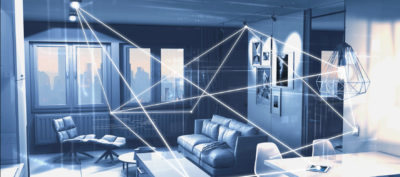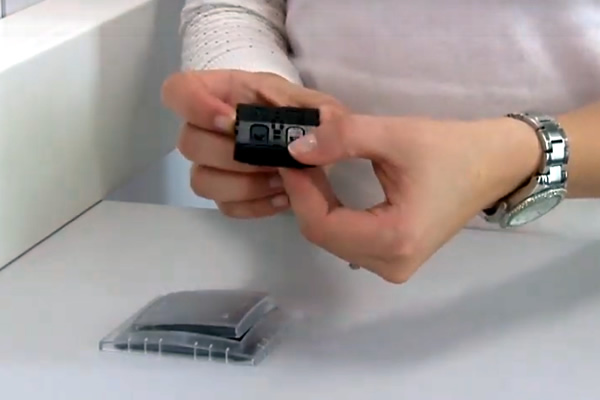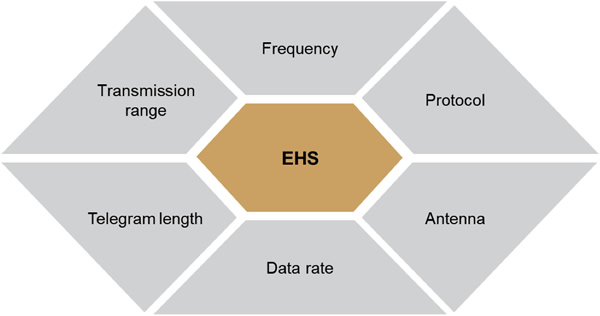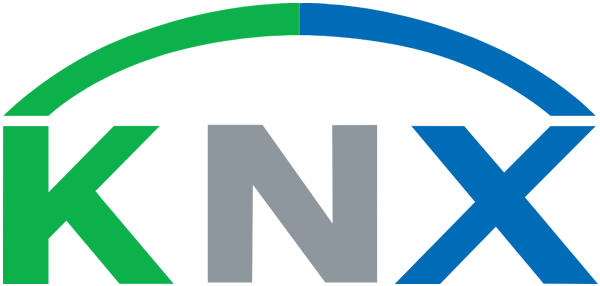 By Simon Ziegler, ZF Friedrichshafen AG.
By Simon Ziegler, ZF Friedrichshafen AG.
Due to the rising connectivity of mobile devices, industrial applications, smart home applications and vehicles, the importance of wireless technology for data communication is increasing continuously. As a result, wireless technology grew by 32% in 2018 compared to the previous year, and now accounts for 6% of the total industrial network market. This communication medium ranges from wireless data transmission over long distances using conventional LTE (Long-Term Evolution (4G)) and future 5G technology, to short distances via mesh networks.

Nearly every innovative and smart application benefits from the wireless technology which is continuously improved and optimised. Some businesses are building on this opportunity to develop smart sensors and energy-efficient actuators. One example is the Energy Harvesting Switch (EHS) from ZF. In addition to electronic and mechanical components, software with various radio protocols is offered which enable data exchange between devices. Depending on the application, various radio protocols have become established in the market which have different properties, and therefore their own advantages and disadvantages.
This article will highlight the most important design parameters and their correlations using the ZF energy self-sufficient and wireless switch as an example.

Long-range versus short-range radio frequencies
Data transmission over long distances currently takes place via LTE, and in the future, will take place through 5G technology. Due to its long range from 1 to 10 kilometres and its high data rate from 100,000kbps (LTE) and up to 2,000,000kbps (5G), this wireless technology can be used for a broad spectrum of applications. This includes vehicle-to-vehicle communication, driverless transport systems, working with drones, autonomous driving and virtual/augmented reality. The advantage of this wireless technology is that large volumes of data can be transmitted over long distances.
Mesh networks have a lower distance range compared to 5G with around 10 meters in the building and up to 500 meters outdoors. The data rate is also much lower at 0.5 to 100kbps. Unlike LTE or 5G, however, there are no transfer fees, and energy consumption is significantly lower. Therefore, mesh networks are used primarily in the smart home area for building management, lighting control and monitoring. An essential feature of mesh networks is their decentralised architecture. By means of the meshing of sensors and actuators, multiple communication paths exist to transmit information from a source to a paired end-device. This technology improves not only the transmission range but also the transmission reliability.

The ZF Energy Harvesting Switch – an elegant solution for building automation
ZF’s energy self-sufficient and wireless switch is a battery-free alternative for triggering actions not only within a wireless infrastructure of a mesh network, but also for point-to-point communication. In this application, the energy harvesting technology of the switch is extraordinary. The simple mechanical act of pressing the switch is enough to send out a reliable and multi-redundant radio signal. This signal contains all of the essential information required for communication between connected devices.

For data communication, various types of protocols have prevailed in the market. The most popular and well known are W-LAN, Wi-Fi and Bluetooth, as well as ZigBee, KNX RF, EnOcean and Z-Wave. The reason for this diversity of protocols is that each has different properties that are suitable for certain applications and end devices.
ZF’s Energy Harvesting Switch can be used universally. It already supports standards such as KNX RF, Bluetooth, EnOcean and ZigBee, and is currently the only wireless switch that can send out a KNX RF telegram several times redundantly (>7) without a battery or external power supply. For this, ZF uses a microchip provided by On Semiconductor, which is ideal for this application due to its very low energy consumption. This allows the ZF EHS to be flexibly integrated into almost every system, be it the smart home, industrial applications or in the field of micro mobility/e-bikes.
Functionality and design considerations
A protocol can be likened to a language which is used by different devices in a system as a communication medium. The information itself is transmitted via a telegram in the respective language. The telegram length differs from protocol to protocol, and the longer the telegram, the more energy is needed.
Each standard protocol is based on a fixed frequency band which supports the exchange and transmission of information. Every region has its own approvals including information about which frequency ranges can be used, and each country has its preferred radio protocol. It depends on the industry sector and its specific requirements as to which kind of protocol can be used, as each of them has unique characteristics. In building automation, for example, KNX RF with 868MHz frequency has become established in Europe due to its very good penetration of walls and obstacles. So as a first step, a target market has to be identified before a new radio application, such as EHS, can be developed.
The frequency not only affects the amount of required energy to send out telegrams, but it also influences the radio range and the antenna design. Therefore, the chosen protocol significantly influences the development work for the energy converter, the required energy management and the radio technology of an EHS.

As the target is to use the energy self-sufficient radio switch universally, it must be compatible with the most important standard protocols that are currently available on the market, and must be able to create a certain minimal amount of energy to send out the respective routing protocols.
Another parameter is the data rate (number of bits transmitted per second) which is defined by the type of protocol. The higher the frequency, the higher the data rate. The telegram length and the data rate in turn influence the data transmission time. This parameter indicates the required time to send a telegram from a sender to a paired receiver.
Frequency range
Each radio protocol is based on a certain frequency range. The so-called ISM (Industrial, Scientific and Medical) bands are frequency ranges that can be used without any licenses or approvals. The VO Funk operates worldwide and regulates radio services and the use of radio frequencies based on international law.

Note: Type A frequencies must be approved by the respective regional authorities;
Type B frequency ranges are freely available and approved for specific regions.
In addition to the ISM band there are other frequency ranges that are reserved exclusively for certain regions and are legally different. The SRD (Short Range Devices) band from 863 to 870MHz, for example, is available for use in Europe and Asia. Worldwide, most devices on the market operate either at 433MHz (ISM band Region 1), 868MHz (SRD band Europe and Asia) or 915MHz (ISM Band Region 2).
The 2.4GHz frequency is the most common frequency range and can be regarded as the international standard. The reason for its popularity is that it is license-free and usable everywhere. This means that many radio networks operate on this frequency range, including W-LAN/Wi-Fi, ZigBee and Bluetooth. As a result, the vast majority of available devices communicates with these protocols. The problem is that the speed and stability of a wireless network depends on the amount of traffic using that frequency, i.e. the more wireless technologies that are used on the same frequency the more interference-prone it will be.
According to the recommendation of CEPT (European Conference of Postal and Telecommunications Administrations), the ISM band 868MHz is used in Europe as well as in Asia. Within the smart home sector, the most popular KNX RF protocol operates on this frequency band. Other standard protocols such as EnOcean and Z-Wave also rely on this frequency range due to significant advantages, such as lower susceptibility to interference, higher transmission range and better penetration of obstacles.
In the US, the ISM band 915MHz was approved. Standard protocols such as EnOcean, and Z-Wave work on this frequency range too.
Standard protocols
Currently, many different standard protocols exist. The smart home sector in particular is an interesting industry as it is continuously changing and uses a large number of different protocol types. Many companies launch innovative products and offer their own proprietary radio protocols to bind customers to their products.
In addition, electricity consumption is a hot topic. The goal is to consume as little energy as possible, and this aim is share by the EHS, which can operate without an additional energy source. As a consequence, however, it can be applied only in a unidirectional communication system. Unidirectional means that the switch sends a signal only when needed via mechanical actuation, but without the possibility to receive signals back – so it works as a pure radio transmitter. For example, the Z-Wave wireless protocol is a bidirectional wireless communication technology. The transmitter receives a confirmation of receipt, each time, from the receiver, resulting in improved transmission reliability but also meaning that the transmitter needs a constant and additional power supply for signal detection.
The selection of suitable radio protocols depends on the application. This can be the amount of transferred data, the transmission security or the distance range. The following section outlines standard protocols which are compatible with the EHS as they are in line with ZF’s target markets.
KNX RF
KNX RF is a wireless communication protocol used for smart home and building automation. The KNX association has more than 80,000 partners in 190 countries

An advantage of KNX RF is the complete compatibility with the well-known KNX TP (twisted pair) system. This is a 24V bus system, which exchanges data from various sensors and actuators via cable lines at more than 9600bps.
Bluetooth
In its original form, Bluetooth was mainly used to connect headsets, headphones, loudspeakers and car radios. It involves the transmission of continuous data streams, such as audio, music or telephony.

Bluetooth versions beginning from 4.0 are also known as Bluetooth Low Energy (BLE) – a very energy efficient variant of Bluetooth. This results in numerous applications in the areas of health, sports, medicine, consumer electronics, home automation and car electronics. The big advantage of Bluetooth is the compatibility with numerous devices of different companies and industries.
With the introduction of Bluetooth 5.0, the speed of data exchange has been doubled, the distance range has been quadrupled, and the transmission capacity has increased 8-times compared to the 4.0 version. Another advantage is the mesh operation in which each Bluetooth device can forward data from neighbouring devices. In addition, the risk of interference of signals in the same frequency range can be limited by intelligent frequency jumps with up to 1600 jumps per second on free channels.
EnOcean
The EnOcean wireless protocol is mainly used in home automation with focus on energy self-sufficient technologies. In 2012, it was ratified as international standard ISO / IEC 14543-3-10.

ZigBee
ZigBee is a global standard protocol based on the mesh network technology for indoor device communication. ZigBee’s adoption, however, is limited. One reason is that many devices, despite certification, cannot work together with devices from other manufacturers, as many manufacturers try to stand out from the competition and offer their own proprietary functions and protocols. As a result, the ZigBee standard becomes more extensive and can no longer fully support end devices.

Distance range
The distance range of a radio signal is influenced on the one hand by the wavelength and on the other hand by the signal strength. In general, the following statement with constant signal strength is valid: The higher the frequency, the lower the distance range and vice versa. Outdoors, the possible range of radio signals based on 868MHz is 300 meters (referenced to ZF products). But there are also radio signals that can cover much greater distances in this frequency range. As a general guideline, for radio signals based on 2.4GHz, a distance range around 100 meters can be assumed.

In buildings, signals are disturbed by obstacles, resulting in the range being reduced dramatically. Signal strength degradation depends on the material and thickness of the obstacles as well as the placement and arrangement of the paired sensor and receiver unit. For example, metal and concrete have very high damping, whereas glass and wood have low damping. A Bluetooth signal which is generated by the EHS from ZF with a transmission power of 0.33mW and at 0dBm, can reach within a building up to 10 meters. In general, lower frequencies are better at penetrating doors, walls and ceilings.
Telegram length and structure
The structure and length of a telegram are specified by the standard’s protocol. For example, the telegram length for KNX RF is 35 bytes, for ZigBee 21 bytes and for EnOcean 14 bytes. As a rule, the longer the telegram length, the higher the energy required for sending the telegram.
Data rate and data transmission time
The data rate is defined by the protocol type. It indicates how many kbps are transmitted from a sender to a paired receiver. In general, the higher the frequency range, the higher the data rate. Especially in the transmission of large data volumes such as audio streaming services where the data rate plays a significant role. This is the reason why W-LAN radio technology distinguishes itself from others in this area thanks to its enormous data rate.
Above all, data transmission time plays an important role for the ZF EHS. This figure can be calculated using the data rate and telegram length. The longer the telegram and the smaller the data rate is, the longer it takes to get all the data sent out by the transmitter. This means that the radio switch must convert the mechanical actuation energy into an electronic form, store it and deliver it in a throttled form until the signal has been completely transmitted. To ensure transmission security, the same telegram should be broadcast more than three times.
Conclusion
In the areas of building automation, smart home, and industrial applications there are different types of protocols, each with advantages and disadvantages depending on the application. So, the specific requirements must be identified and defined as a first step before installing a wireless network. The properties of the protocols are strongly determined by the underlying frequency. Essential requirements for choosing the right protocol are transmission security and reliability, distance range and energy efficiency.
Through innovative solutions such as frequency jumps in overloaded frequency bands, range extension by intelligent mesh networks and reduction of energy consumption by energy self-sufficient wireless switches, manufacturers are trying to optimise these systems continuously. Further development of radio technology is also helping to explore new applications, for example, to enable autonomous driving with G5 in the future, to make e-bike systems with Bluetooth more intelligent, or to identify free parking spaces by means of integrated radio sensors.
Simon Ziegler is a Junior Product Manager for ZF Friedrichshafen AG , a global technology company and supplies systems for passenger cars, commercial vehicles and industrial technology, enabling the next generation of mobility. ZF continually enhances its systems in the areas of digital connectivity and automation in order to allow vehicles to see, think and act. ZF also offers a wireless, battery-free technology which is both environmentally friendly, and maintenance-free for a range of environments and applications.











